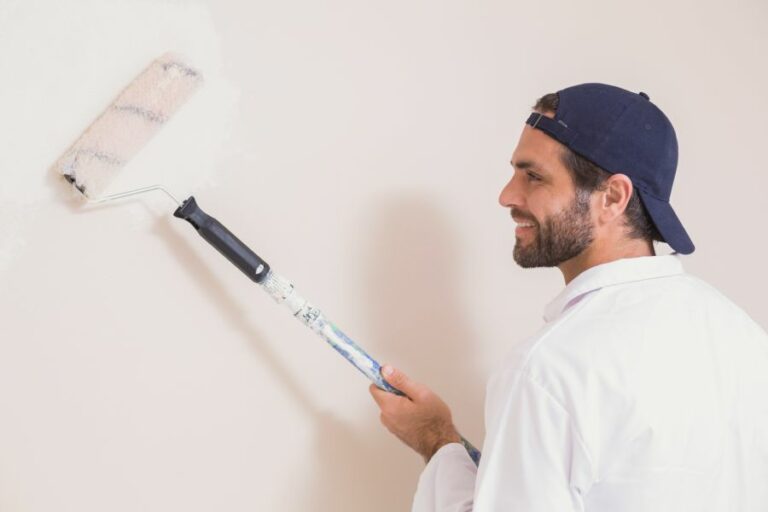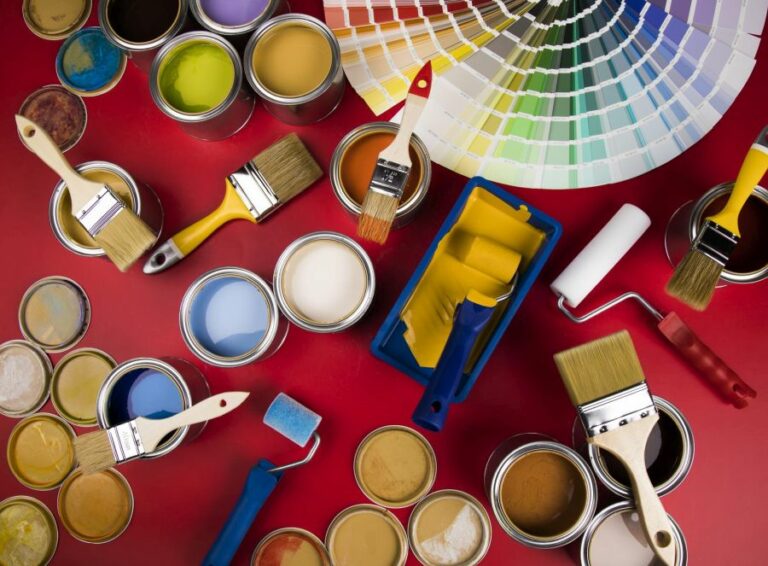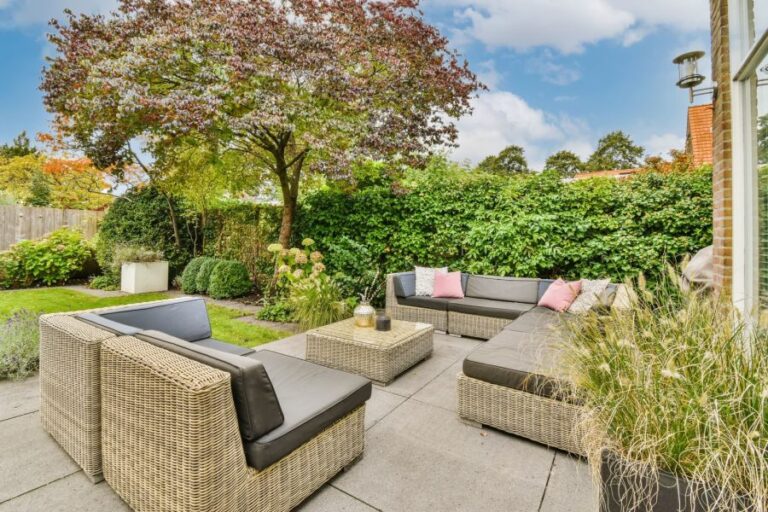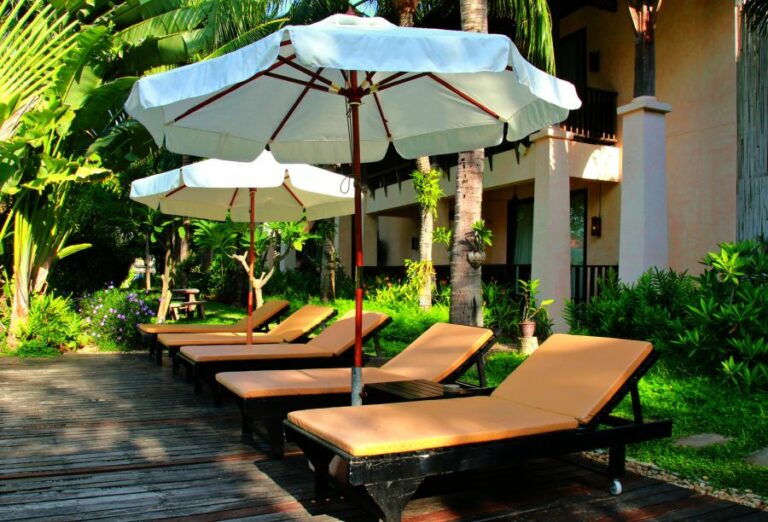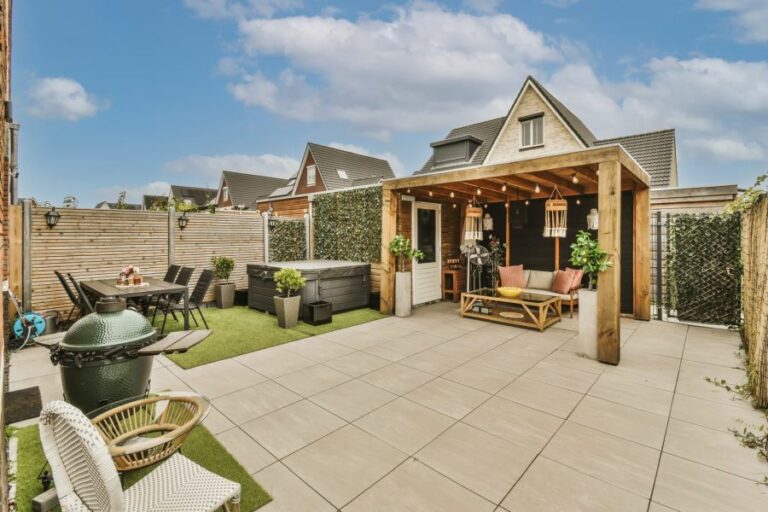Outdoor Wall Paint Ideas, 25 Things You Should Know
Looking for a way to transform your home’s exterior? Get ready to unleash your creativity with these outdoor wall paint ideas! I will guide you through giving your abode a fresh face, whether you desire a bold statement, subtle sophistication, or a cozy, warm invitation for guests. Packed with design inspiration and tips, I will help you feel confident and excited to rejuvenate your home. Let’s transform your outdoor walls into stunning masterpieces!
Outdoor wall paint ideas:
When painting outdoor walls, use high-quality, weather-resistant paint like latex or elastomeric paint for its durability and protection against various elements such as rain, sunlight, and temperature fluctuations. Prepare the surface by cleaning, repairing damages, and priming the wall, then choose from different color schemes, like monochromatic or complementary, and textured techniques like stippling or sponge painting to create a visually appealing and personalized exterior space.

As you embark on your exterior upgrade journey, I’ve collected a variety of creative outdoor wall paint ideas to inspire your transformation. Discover refreshing color schemes, unique textures, and modern designs to elevate your home’s curb appeal today! Don’t miss these stunning tips!
Contents
- 1 Exterior Wall Painting Concepts and Inspiration
- 2 Identifying the Most Popular Color for Exterior Walls
- 3 Identifying the Optimal Paint Choice for Exterior Walls
- 4 What is the Most Long-Lasting and Durable Exterior Wall Paint?
Exterior Wall Painting Concepts and Inspiration
• Choosing the Right Paint for Outdoor Walls
When painting outdoor walls, the first step is to consider the kind of paint best suited for the job. I recommend using high-quality paint with weather-resistant properties, which can withstand various outdoor elements, such as rain, sunlight, and temperature fluctuations.
– Latex Paint
Latex paint is an excellent choice for outdoor walls due to its durability and easy-to-maintain finish. This type of paint provides good coverage, adheres well to surfaces, and is resistant to mildew and fading.
Moreover, latex paint dries quickly, which can be highly beneficial if you’re trying to complete your painting project within a limited time frame.
– Elastomeric Paint
Elastomeric paint is another great option for outdoor walls, especially when dealing with surfaces prone to cracks or water seepage. This high-build paint has an elastic quality, allowing it to expand and contract with the wall, effectively bridging minor cracks and preventing water infiltration.
Additionally, elastomeric paint offers excellent durability and UV resistance, making it a suitable choice for outdoor walls that experience constant exposure to the elements.
• Painting Outdoor Walls: Preparation Tips
Before diving into the various outdoor wall paint ideas, preparing the surface to ensure a flawless finish properly is essential. This process entails several steps, including cleaning, repairing, and priming the wall.
– Cleaning the Surface
Start by thoroughly cleaning the wall to remove dirt, dust, and mildew. I recommend using a pressure washer to achieve optimum results, as it can effectively reach every nook and cranny of the wall’s surface. It’s essential to allow the wall to dry completely before proceeding with the painting process.
– Repairing Damages
Inspect the wall for any damages, such as cracks or holes, and repair them accordingly. For small cracks, use a good-quality exterior-grade caulk to fill the gaps. Patch larger cracks or holes with cement or mortar, following the manufacturer’s instructions for proper application and drying time.
– Priming the Surface
I highly recommend applying a coat of primer on the wall surface before painting. This step helps in creating a solid, even base for the paint, ensuring better adhesion and longevity. Opt for primers specifically designed for outdoor use for the best results.
• Outdoor Wall Paint Ideas: Color Schemes and Techniques
Now that the wall is prepped and ready for painting, it’s time to explore various color schemes and techniques for reinvigorating your outdoor space. Here are some ideas to fuel your creativity:
– Monochromatic Color Scheme
A monochromatic color scheme involves selecting different shades, tints, or tones of a single color for your outdoor wall. This approach creates a cohesive, elegant, and sophisticated look that never goes out of style.
Choose a color that complements or contrasts the overall outdoor decor and landscaping for a harmonious visual balance.
– Complementary Color Scheme
A complementary color scheme involves using colors that lie opposite each other on the color wheel. For example, pairing blue with orange or purple with yellow can create a vibrant and striking effect on outdoor walls.
I recommend opting for softer hues rather than bold, saturated colors to avoid overpowering the senses.
– Textured Wall Painting Techniques
In addition to playing with color schemes, experimenting with textured painting techniques can add depth and visual interest to your outdoor wall. Below are two techniques I personally recommend trying:
Stippling
Stippling involves using a stippling brush, a small, round, and flat paintbrush with stiff bristles, to create a textured pattern on the wall. Begin by applying a base coat to the wall, then while the base coat is still wet, dab the paintbrush onto the wall in a stippling motion.
This technique creates a beautiful, organic pattern that can add an interesting dimension to your outdoor space.
Sponge Painting
Sponge painting is another easy-to-master textured painting technique. All you need is a paint sponge and your choice of paint color. Start by applying a base coat to the wall, then dip the sponge into the paint and gently dab it onto the wall in a random pattern.
You can use one color or layer multiple shades for a more complex, visually appealing design.
In conclusion, painting your outdoor walls allows you to revamp and refresh your exterior space without making significant, costly changes.
With the right choice of paint and various color schemes and techniques at your disposal, you can create an outdoor oasis that reflects your personal style and aesthetic preferences. So gather your tools and unleash your creativity. Your outdoor walls await a dazzling transformation!
Paint Idea | Description |
|---|---|
Bright Colored Accent Wall | Create a bold and vibrant outdoor space by painting a single wall with a bright, eye-catching color. |
Mural | Commission a local artist or create your own large-scale design to transform an outdoor wall into a work of art. |
Geometric Patterns | Use painter’s tape to create unique and interesting geometric patterns on your outdoor wall for a modern look. |
Textured Paint | Apply textured paint for a more tactile and visually interesting finish on your outdoor wall. |
Faux Stone or Brick Design | Use paint techniques to create the illusion of stone or brick on your outdoor wall for a more rustic feel. |
Weathered Look | Use paint layering techniques to create the look of aged and weathered paint on your outdoor wall for added character. |
Natural Colors | Choose paint colors that mimic natural surroundings, such as earth tones or shades of green, to create a serene and calming outdoor space. |
Identifying the Most Popular Color for Exterior Walls
Selecting the perfect color for your home’s exterior walls is essential to creating a visually appealing and welcoming atmosphere. The right color can elevate the overall aesthetic, while the wrong choice has the potential to detract from your home’s attractiveness.
With countless colors to choose from, it is crucial to identify the most popular and timeless choices available.
• Neutral Colors: The Timeless Appeal
Neutral colors are universally appealing and usually don’t go out of style. They provide a solid foundation for adding accent colors and patterns, further enhancing your home’s curb appeal. Some popular neutral colors include:
– White
White is arguably the most popular and timeless color choice for exterior walls. A classic and clean look, white exteriors present an elegant and sophisticated appearance.
Additionally, white pairs well with a multitude of accent colors, allowing for endless customization options. White exteriors also tend to evoke a sense of cleanliness and purity.
– Gray
Gray is an incredibly versatile color frequently used for exterior walls. Ranging from light, airy shades to darker, bolder hues, gray provides a contemporary feel while remaining neutral enough to suit various architectural styles.
Gray is particularly popular among modern and minimalist homes, as it offers the perfect base for bold accents and unique design features.
– Beige
Beige is another popular neutral color that works well for exteriors. This warm, versatile shade complements various accents, colors, and design elements, providing a comfortable and welcoming atmosphere.
Beige is particularly suitable for traditional or classic home designs, as it creates a cozy and timeless aesthetic.
• Earth Tones: A Natural Connection
Earth tones are another popular category of colors for exterior walls. These colors are inspired by nature, promoting a sense of harmony and balance. Some popular earth-toned colors include:
– Taupe
Taupe is a versatile and understated color, often described as a pleasant mix between beige and gray. Its neutral qualities make it an excellent choice for numerous architectural styles, while its earthy undertones create a sense of warmth and connection to nature.
Taupe exteriors are particularly appealing to homeowners seeking a timeless and elegant color option.
– Sage Green
Sage green is an increasingly popular choice for exterior walls, particularly among homeowners gravitating toward a sustainable and eco-friendly aesthetic.
This muted, earthy green creates a calming and peaceful atmosphere while simultaneously providing a refreshing change of pace from traditional neutral tones. Sage green also pairs exceptionally well with natural materials like wood and stone accents.
– Terracotta
Terracotta, a warm and earthy shade of red-orange, is a popular choice for homes with Spanish, Mediterranean, or southwestern architectural styles. This rich and vibrant color is reminiscent of sun-baked clay, evoking a sense of warmth and natural beauty.
Terracotta is an excellent way to make a bold statement while still maintaining a connection to the environment.
• Bold Colors: Making a Statement
While neutral and earth tones are popular choices for exterior walls, some homeowners prefer to make a bolder statement with their home’s exterior. Striking and memorable, these colors make a strong impression and stand out in the neighborhood. A few popular bold colors include:
Navy blue is a bold color choice that adds depth and sophistication to an exterior. The shade is the perfect balance of eye-catching and elegant, making it a popular choice among homeowners seeking to make a statement.
Navy blue exteriors also work well with various design elements and accent colors, resulting in a versatile and modern aesthetic.
– Black
Black exteriors have recently gained popularity among homeowners seeking a dramatic, high-impact design. This bold and unconventional choice conveys a sense of modern luxury with its ability to make a home seem sleek and sophisticated.
Paired with the correct accents and landscaping, black exteriors can truly make a striking statement.
– Red
Red is a captivating color choice for an exterior wall, often associated with warmth, passion, and energy. While a bold choice, red exteriors can evoke a sense of intrigue and grandeur.
Red also pairs nicely with complementary accent colors like white or gray, creating a visually appealing and memorable home facade.
• Final Thoughts
The most popular color for exterior walls varies depending on personal preferences, architectural styles, and geographic location.
However, neutral colors, such as white, gray, beige, and earth tones, including taupe, sage green, and terracotta, are popular choices. Meanwhile, bold colors like navy blue, black, and red make a striking statement and create memorable curb appeal.
In conclusion, choosing the perfect color for your home’s exterior is vital to creating a visually appealing and welcoming atmosphere.
By researching popular and timeless color choices and considering your home’s unique qualities, you can select the ideal shade to create a stunning and impressive exterior that you’ll be proud to call home.
Identifying the Optimal Paint Choice for Exterior Walls
When it comes to painting the exterior walls of your home or building, the first thing to consider is the type of paint that will provide maximum protection against weather elements and make your walls look fantastic.
• Understanding the Importance of Exterior Wall Paints
Choosing the right paint for your outside walls not only enhances the overall appearance of your property but also offers protection against harsh weather conditions, UV rays, and moisture.
Just like you protect yourself from environmental elements like rain or sunlight, your walls, too, require the same consideration. A high-quality exterior paint can significantly affect the durability and maintenance of your home or building.
• Factors to Consider When Choosing Exterior Paint
Before diving into the types of paints available, it is essential to understand the factors that can impact your choice. These factors will help you make an informed decision and select the best paint for your outside walls.
– Surface Material
The surface material of your walls, whether brick, wood, metal, or stucco, is one of the primary factors when choosing exterior paint. Various surface materials have different paint adhesion requirements; some may even require priming before applying the paint.
– Weather Conditions
The climate in your region plays a vital role in determining the ideal exterior paint. For areas with high humidity, you need to opt for paints with good moisture resistance.
On the other hand, if your location constantly experiences harsh sunlight, you may want to choose a paint that offers excellent UV protection.
– Desired Finish and Aesthetics
Your preference for the final appearance of your walls matters too. Different types of paints can provide a glossy, matte, or semi-glossy finish, which can add to the overall aesthetic value of your home or building.
• Types of Exterior Paints and Their Benefits
With a clear understanding of the factors influencing your choice of exterior paint, let’s explore the popular exterior paint options and their respective advantages.
– Acrylic Paints: The Most Popular Choice
Acrylic paints are water-based, making them popular for exterior wall applications. They are available in gloss, semi-gloss, and matte finishes, providing a wide range of options to achieve the desired aesthetics.
Benefits of Acrylic Paints:
- Quick-drying: Acrylic paints dry fast, which means you don’t have to worry about the paint getting damaged in case of unexpected rain.
- Long-lasting: Acrylic paints are known for their durability and can last up to 20 years with proper maintenance.
- Low odor: Since they’re water-based, acrylic paints have a low odor, making them less irritating during application.
- UV resistant: Most acrylic paints have built-in UV resistance, protecting your walls from fading due to sunlight exposure.
– Lime-based Paints: Eco-friendly and Durable Option
Made from lime, lime-based paints are a natural and eco-friendly option for painting the exterior walls of your home or building. They are best suited for porous surfaces like brick and stone but may not be suitable for non-porous surfaces like metal.
Benefits of Lime-based Paints:
- Breathability: Lime-based paints are breathable, allowing moisture to escape the walls and preventing dampness.
- Long lifespan: These paints can last for several decades with proper maintenance, making them an excellent long-term investment.
- Eco-friendly: Given their natural ingredients, lime-based paints are a more environmentally friendly option.
- Antifungal and antibacterial properties: Lime-based paints are known to resist mold and mildew growth, which can be beneficial for buildings in humid regions.
– Elastomeric Paints: For Exceptional Protection
If you’re looking for a paint that offers top-notch protection against moisture and external elements, elastomeric paints might be the ideal choice. These paints can bridge small cracks and gaps in the surface, resulting in a seamless, water-resistant finish.
Benefits of Elastomeric Paints:
- High elasticity: Elastomeric paints can stretch exceptionally, providing a flexible protective layer that can accommodate the natural expansion and contraction of your walls due to temperature changes.
- Waterproof: These paints offer excellent water resistance, preventing moisture seepage and the resulting damage.
- Durable: Elastomeric paints can last for more than 20 years with proper maintenance, making them a worthy investment.
- Crack prevention: The elastic nature of these paints helps in preventing the formation of hairline cracks in the wall surface.
• Final Thoughts and Recommendations
Ultimately, the best paint for your outside walls depends on your specific requirements and the factors discussed in this guide. However, in most cases, acrylic paints are considered the top choice for their combination of durability, quick-drying properties, and UV resistance.
In case you prefer a more eco-friendly option, lime-based paints can offer breathability and long-lasting protection. For those living in areas prone to moisture and heavy rainfall, elastomeric paints can provide exceptional waterproofing and flexibility to your exterior walls.
Always remember, proper surface preparation, priming (when needed), and adherence to the manufacturer’s instructions can significantly affect the performance and longevity of your chosen exterior paint.
By carefully considering your specific needs and the benefits each type of paint offers, you can confidently select the best paint for your outside walls and enhance the beauty and protection of your home or building.
• Choosing the Right Color for the Outdoor Walls of Your Home
Selecting the right color for your home’s exterior can be quite a challenge. With a vast array of options and factors to consider, it is imperative to make an informed decision for long-lasting satisfaction.
– Materials and Architectural Style
One of the first aspects to take into account when selecting a color for your outdoor walls is the material of your home’s exterior. Different materials offer varying degrees of adherence and aesthetic appeal with certain colors.
For instance, brick exteriors tend to look best with earthy, warm tones, while wood siding can work well with a wide range of shades.
The architectural style of your home should also influence your color choice. Traditional homes will often benefit from classic colors, such as white, beige, and gray.
Conversely, contemporary homes, which emphasize clean lines and modern design elements, may look best with bold, contrasting colors or monochromatic schemes. If you’re uncertain about matching your home’s style, consult a professional or research similar homes for inspiration.
– Surroundings and Neighborhood Compatibility
Considering your neighborhood’s overall look and feel is crucial when selecting a color for your outdoor walls. Homes that blend harmoniously with their surroundings are more visually appealing and may contribute to increased property value.
In a neighborhood with predominantly neutral-colored homes, a bright, bold exterior may stand out too much and appear out of place.
A home in a colorful or eclectic neighborhood may benefit from a more vibrant exterior. Keep in mind that some neighborhoods may have guidelines or restrictions in place regarding paint colors. Be sure to consult these before making a decision.
– Climate Considerations
The climate in which your home is located can also considerably impact the best color choices for your outdoor walls.
In particularly sunny and warm climates, lighter colors can help to reflect heat and keep your home cooler, increasing energy efficiency. Lighter shades are also less likely to suffer from fading over time due to sun exposure.
On the other hand, homes located in colder climates may benefit from darker colors that absorb and retain heat. Additionally, darker shades can withstand harsher weather conditions and may be more resistant to moisture, mildew, and other climate-related challenges.
– Personal Preferences and Lifestyle
Ultimately, the paint color you choose for your home’s exterior should reflect your personality and lifestyle. If you have a favorite color, consider finding a shade that complements your home’s style and surroundings.
If you prefer a certain “feel” or “mood” for your home, experiment with various color combinations until you find one that resonates with your preferences.
It is essential to factor in the level of maintenance you are willing to commit to when selecting a color for your outdoor walls. Bold, vibrant colors may require more frequent touch-ups, while neutral, light colors may show dirt and stains more readily.
– Experimenting with Colors and Getting a Professional Opinion
Before making a final decision on the color of your outdoor walls, it is wise to experiment with various options. Paint samples can provide a helpful visualization of how a particular color will look on your home’s exterior.
Attach these samples to your home and view them in different types of lighting, including daylight and nighttime conditions.
Seeking the input of a professional, such as a color consultant or designer, can further assist in narrowing down your options and making an informed decision. These experts can provide valuable insights into current trends, color combinations, and other factors that should be considered in the selection process.
• Conclusion
Choosing the right color for your home’s outdoor walls can enhance its curb appeal, harmonize with its surroundings, and reflect your personal preferences.
By carefully considering the factors discussed in this article, such as architectural style, neighborhood compatibility, climate, and personal preferences, you will be on your way to selecting the perfect color for your home’s exterior.
What is the Most Long-Lasting and Durable Exterior Wall Paint?
Exterior wall paint not only adds color and beauty to your home or building but also protects against various environmental factors such as sun, rain, snow, and wind. A durable exterior paint is essential to ensure longevity and low maintenance costs.
• Types of Exterior Paints
There are three primary types of exterior paints based on their composition: water-based (latex), oil-based (alkyd), and mineral-based (silicate).
Each type of paint has its own set of advantages and disadvantages, making it crucial to understand the differences between them to make an informed decision.
– Water-based (Latex) Paints
Water-based paints, commonly known as latex paints, are the most prevalent type of exterior wall paint. These paints consist of a water-soluble base and are resistant to cracking, resistant to fading and easy to clean.
Advantages:
- Quick-drying, generally within one to two hours.
- Resistant to mold and mildew.
- Low volatile organic compounds (VOCs) make them more environmentally friendly.
- Flexible, allowing the paint to expand and contract with changing temperatures.
- Easy to clean, usually only requiring soap and water.
Disadvantages:
- May not adhere well to certain surfaces or previously painted surfaces, especially if previously coated with oil-based paint.
– Oil-based (Alkyd) Paints
Oil-based paints, also known as alkyd paints, consist of drying oil, such as linseed oil, as the primary binder. These paints provide superior surface adhesion and a durable, glossier finish.
Advantages:
- Excellent adhesion to various surfaces, including previously painted surfaces.
- Excellent adhesion to various surfaces, including previously painted surfaces.
- Durable, providing a long-lasting finish.
- Resistant to stains, making it ideal for areas exposed to heavy wear and tear.
Disadvantages:
- Longer drying time, typically around 24 hours.
- High VOCs, posing potential environmental and health concerns.
- Require thinners and solvents for cleanup.
- Less flexible, increasing the likelihood of cracking.
– Mineral-based (Silicate) Paints
Mineral-based paints, also known as silicate or mineral paints, consist of a mixture of inorganic minerals, such as potassium silicate, as the primary binder. These paints form a chemical bond with the substrate, resulting in a highly durable and breathable finish.
Advantages:
- Highly durable and long-lasting, often lasting over 50 years with proper application.
- Breathable, allowing moisture to escape from the wall and reducing the likelihood of trapped moisture and mold growth.
- Resistant to fading, alkali, and pollutants.
Disadvantages:
- Expensive compared to other paints.
- Limited color range, primarily due to their inorganic composition.
- Require a specific substrate conditioned with a primer or a thoroughly cleaned surface for proper adhesion.
• Factors to Consider when Choosing Paint
Before you choose a paint type for your exterior walls, consider the following factors:
- Surface Material: Evaluate the material of the wall you will be painting. Ensure the type of paint you choose is compatible with the material and complements its features.
- Climate Conditions: Consider the local weather conditions when selecting a paint type. For instance, if you live in an area with high humidity, choose a paint with mold and mildew resistance.
- Existing Paint: Determine if the surface is oil- or water-based. Applying water-based paint over oil-based paint may result in poor adhesion and possible peeling.
- Maintenance Requirements: Prioritize your expectations for long-term performance and decide which paint type best aligns with your desired maintenance schedule and budget.
- Environmental Impact: Consider choosing paint with low VOCs to minimize environmental impact and health risks.
• Choosing the Most Durable Exterior Wall Paint
Based on the factors mentioned above and the advantages and disadvantages of each type of exterior paint, the most durable exterior wall paint will vary depending on the specific requirements of your project.
- Water-based (Latex) Paints: Latex paints are recommended for homeowners who want eco-friendly, flexible, easy-to-maintain paint that can withstand changing weather conditions.
- Oil-based (Alkyd) Paints: Oil-based paints are recommended for projects requiring exceptional durability and stain resistance. However, keep in mind the environmental and health concerns associated with high VOCs.
- Mineral-based (Silicate) Paints: Mineral-based paints are a top choice for those looking for a long-lasting, breathable, and fade-resistant finish but can be cost-prohibitive for some budgets.
• Final Thoughts
In conclusion, there is no one-size-fits-all solution when it comes to choosing the most durable exterior wall paint.
Factors such as surface material, existing paint, weather conditions, and maintenance requirements significantly determine the best paint for your project. Always consult with a professional painter or paint supplier to make the most informed decision for your specific needs.

